COMMENTARY
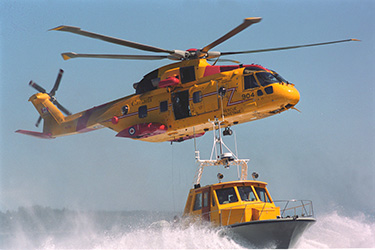
Credit: DND photo CX2003-0254-12c by Master Corporal Rebecca Bell
Cormorant helicopter over a rescue launch
Reflections on Search and Rescue
by Martin Shadwick
For more information on accessing this file, please visit our help page.
Evaluations and critiques of Canada’s national search and rescue system—or portions thereof—continue to appear with an almost predictable regularity. Offerings in recent years have included a May 2009 audit of the fixed-wing search and rescue (SAR) aircraft project by DND’s Chief Review Services (CRS), an April 2009 Summative Evaluation of the Contribution to the Civil Air Search and Rescue Association (CASARA), also from CRS, the House of Commons Standing Committee on National Defence study of SAR response times, the 2011 report on Arctic sovereignty and security by the Standing Senate Committee on National Security and Defence, and two refreshingly blunt National Research Council reports on the Statement of Operational Requirement for the fixed-wing search and rescue aircraft. Other contributions to the expanding literature have included Search and Replace: The Case for a Made-in-Canada Fixed-Wing Search and Rescue Fleet by Michael Byers and Stewart Webb (Canadian Centre for Policy Alternatives and the Rideau Institute, June 2012) and, most recently, the Spring 2013 report from the Office of the Auditor General (OAG) of Canada.
Tabled on 30 April 2013, the OAG audit examined whether “federal organizations are ready to respond to incidents that require search and rescue, have implemented prevention activities to reduce the number and severity of such incidents, and adequately administer search and rescue activities. We examined federal organizations’ state of readiness to respond to such incidents, and whether human resources, equipment, and information technology systems are in place to respond.” The audit “focused on federal support to marine and air search and rescue activities” and included the relevant functions of “National Defence and the Canadian Forces, Fisheries and Oceans Canada and the Canadian Coast Guard, and Transport Canada. We did not audit provincial and municipal search and rescue activities, nor did we examine search and rescue activities of the Royal Canadian Mounted Police.”
“Overall,” the OAG found that “federal search and rescue activities have met established minimum standards of readiness to respond when people in distress need assistance. However, two factors present significant risks to readiness: the continued availability of sufficient numbers of trained [SAR] personnel, and the maintenance of aging equipment. Significant improvements are needed if the Canadian [Armed – ed] Forces and the Canadian Coast Guard are to continue to adequately respond and provide the necessary personnel, equipment, and information systems to deliver SAR activities effectively.” While the “Canadian [Armed] Forces and the Canadian Coast Guard adequately respond to air and marine SAR incidents,” argued the report, ongoing “staffing and training challenges are impacting the sustainability of SAR operations. SAR activities have also been affected by the Royal Canadian Air Force’s continued use of older airplanes that require extensive maintenance and of helicopters that are either insufficient in number or less capable of responding to incidents.” In addition, “the information management system used to manage search and rescue cases does not adequately support operational requirements and is nearing its breaking point. System failures, such as the one experienced in 2009, could delay responding to an incident. A replacement system is not expected until 2015-16, and National Defence does not have a plan to address this gap.” Although the audit team concluded that the SAR “roles and responsibilities are clear at the operational level for the Canadian [Armed] Forces and the Canadian Coast Guard, the departments do not have a common set of principles for coordinating with other levels of government on national matters. In addition, the National Search and Rescue Secretariat [NSS] has not implemented its 1986 mandate to establish a national policy framework, nor does it have the ability to measure overall federal program performance.”
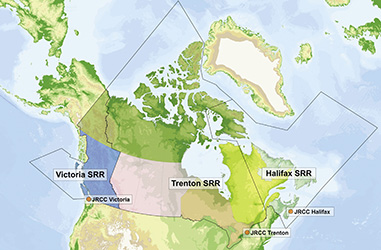
Credit: Royal Canadian Air Force, Search and Rescue Canada
Map of Canadian SAR network
On readiness, the OAG noted that “the minimum state of readiness for Air Force rescue squadrons as measured by reaction time is to have the tasked assets depart within 30 minutes, from Monday to Friday between 8 a.m. and 4 p.m., and within two hours on evenings and weekends” but took note of a 2012 military study that concluded that “the current state of readiness does not reflect the busy periods of commercial fishing and recreational activity.” The OAG’s own audit “found that, without increasing the number of hours worked, shifting the regular weekly schedules could have increased readiness for SAR alerts by 9 percent in the Victoria SAR region, 32 percent in the Trenton region, and marginal amounts in the Halifax region.” It also found that the military “does not regularly review whether its states of readiness are still appropriate to meet expected needs” and that “current readiness standards were set using the resources available rather than a needs analysis.” The OAG recommended that “National Defence should systematically analyze its search and rescue data, including its states of readiness, so that its provision of service is based on current and anticipated [SAR] needs.” DND’s in-report response agreed with this recommendation, stating that it “will review its approach to ensure that it captures and systematically analyzes data and, through [Defence Research and Development Canada], will continue to examine the performance of [RCAF SAR] assets in order to ensure that SAR response meets the aeronautical and maritime SAR needs of Canadians…” DND’s response also posited that “the recently initiated National Defence/Canadian Forces and Fisheries and Oceans/Canadian Coast Guard Search and Rescue Operational Governance Committee will improve on the analysis and annual report of aeronautical and maritime SAR incidents…so that provision of services continues to be based on current and anticipated aeronautical and maritime needs.”
On the nettlesome question of human resources, the OAG expressed concern over shortages of SAR personnel, including pilots, flight engineers and Joint Rescue Coordination Centre (JRCC) air controllers and assistant air controllers, the loss of experienced personnel (thereby placing “more pressure…upon less experienced [aircrews])”, and difficulties—including a shortage of aircraft—in training SAR aircrew. The OAG recommended that DND “should assign a sufficient number of [SAR] personnel to continue to meet operational needs and provide for the necessary training, professional development, and leave of search and rescue personnel.” In its response, DND reported that the RCAF “currently staffs its [SAR] squadrons to 100 percent of the target personnel levels and will continue to ensure that SAR services are delivered effectively. National Defence will continue its assessment of relevant policies and their applications in relation to SAR squadrons’ staffing levels, and will determine options to address any identified concerns.” A sceptic might note, however, that determining options is no guarantee that any those options will actually be implemented.
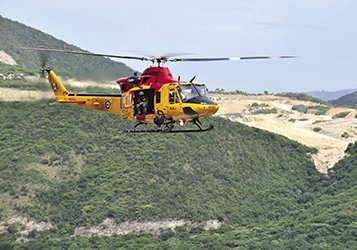
Credit: DND photo IS2011-4064-01 by Master Corporal Shilo Adamson
A Canadian Armed Forces CH-146 Griffon Search and Rescue helicopter manoeuvres through the hills during a training exercise near Kingston, Jamaica.
On the materiel side of the SAR ledger, the OAG took note of recent improvements in the availability rate of the 14-strong CH-149 Cormorant fleet, but cautioned that “corrosion from salt water is increasing maintenance needs, with at least two helicopters always in maintenance”. The report added that the Cormorants once assigned to CFB Trenton had been replaced by CH-146 Griffons on a “temporary basis”—what a marvelously elastic term!—but faulted the Griffon for its modest size and range and lack of de-icing. The OAG noted that the CC-130 Hercules, the backbone of the fixed-wing SAR fleet, lacked “the sensors and data management systems found on modern SAR [aircraft]” and confronted increasing availability issues. Its stable mate, the CC-115 Buffalo, was likewise criticized for age-related availability issues. The OAG report recommended that DND “should give priority to the acquisition of new aircraft that are best suited for search and rescue activities and ensure that it has sufficient numbers of these aircraft resources to meet [SAR] needs on an ongoing basis.” DND’s response agreed with this recommendation, adding that contract award for the new fixed-wing SAR aircraft was “expected” in 2014-2015, that the Cormorant had flown “a record number of hours in 2012”, and that the Griffon fleet “has undergone enhancements, which are allowing it to provide a more robust SAR capability.”
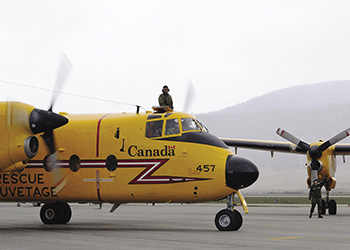
Credit: DND photo CX2013-0060-40 by Corporal Sylvie Kervin
A Buffalo Search and Rescue aircraft of 442 Transport and Rescue Squadron, 19 Wing, Comox, British Columbia
On governance, the OAG’s report examined “whether the government has developed a [SAR] policy and whether there is an appropriate governance structure to plan, coordinate, monitor, analyze, and report on current and future SAR activities and needs.” The results were not encouraging. “In spite of the many reports and recommendations” over the years for “a national SAR policy, we found that there is still no such policy nor an overall federal policy, planning framework, clear statement of expectations for federal SAR services, or ability to measure overall federal SAR effectiveness. The national SAR system involves federal, provincial, and territorial organizations, so the development of a policy framework would need to include all of these stakeholders. The National Search and Rescue Secretariat (NSS) has made efforts over the years to establish a policy and governance framework, but it has not been successful.” In the absence of a policy “to articulate federal priorities and performance expectations for [SAR], the Canadian Forces and the Canadian Coast Guard each set their own priorities and make their resource allocation, delivery, and procurement decisions.” The OAG also reported that there was no “national performance measurement framework”, even though “the NSS was given responsibility to develop” such a framework. The OAG consequently recommended that “National Defence, in consultation with Fisheries and Oceans Canada, Transport Canada, and other federal departments, and the provinces and territories, should take steps to improve the governance structure, including developing objectives, performance indicators, and reporting that would enhance [SAR] service and coordination.”
DND agreed, stating that “effective governance and coordination among federal departments and with provinces and territories is essential”, and noting that the “recently initiated National Defence/Canadian Forces and Fisheries and Oceans/Canadian Coast Guard Search and Rescue Operational Governance Committee will work to enhance coordination of their respective federal responsibilities for aeronautical and maritime SAR activities. This, in turn, will assist overall coordination. Furthermore, National Defence/Canadian [Armed] Forces, with the support of relevant federal departments, will assess the SAR governance structure at the federal level to determine whether it is optimally designed to effectively execute the SAR mandate across departments and to ensure appropriate coordination with federal-provincial and other responders.”
On 2 May 2013, soon after the tabling of the OAG report—and certainly no coincidence—then-defence minister Peter MacKay announced a six-point plan “to improve Canada’s national Search and Rescue System.” The package included a quadrennial review of SAR to be “led by the Minister of National Defence as the Lead Minister for Search and Rescue with the support of the National Search and Rescue Secretariat.” The review would “provide a comprehensive perspective of Search and Rescue in Canada, with a view to enhance integration and alignment to provide a seamless system for Canadians. We will work with other federal partners including the Canadian Armed Forces, the Canadian Coast Guard, Parks Canada, Public Safety Canada and other departments as well as with provincial/territorial governments [and] Search and Rescue volunteers to systematically assess the evolving needs of [SAR] and how we can work together to ensure those needs are met.” Other elements included the “seasonal optimization” of SAR readiness postures (i.e., “expanded” search and rescue “posture shifts to maintain flexibility to seasons, which already exists during the lobster harvest and Northern activity peak-periods”), an improved SAR asset management system whereby “bases will improve the management and tracking of assets to proactively inform Joint Rescue Coordination Centres of equipment status”, and $16.2 million for the development of satellite-aided search and rescue (i.e., the Medium Earth Orbit Search and Rescue (MEOSAR) and Low Earth Orbit Search and Rescue (LEOSAR) satellite projects “to improve real-time situational awareness and improved vessel tracking.”
Rounding out the package were the completion of the renovated Joint Rescue Coordination Centre in Halifax and a “revamped and improved beacon registration and information website for Canadians.” The minister also noted, in a seemingly deft political touch that went essentially unnoticed, that “as part of this exercise, savings and efficiencies in the Department of National Defence, including some of the funds currently allocated to supporting the [CC-144 Challenger Administrative Flight Service] fleet, will re-allocated to frontline priorities that include search and rescue as a no fail mission for the Canadian Armed Forces.” The following weeks witnessed still further pronouncements on SAR, ranging from the approval of $955,828 (via the SAR New Initiatives Fund) to help equip the Newfoundland and Labrador Search and Rescue Association with a Standardized Radio Real Time Tracking System to a $15 million contract to Kelowna Flightcraft for depot-level maintenance on the CC-115 Buffalo and CC-138 Twin Otter (although the latter is not a primary SAR asset). It was also reported that defence minister MacKay had directed DND to take a second look at whether some of the nine surplus American VH-71 presidential helicopters—originally acquired as a source of spares for the Cormorant—could be made operational for the SAR role.
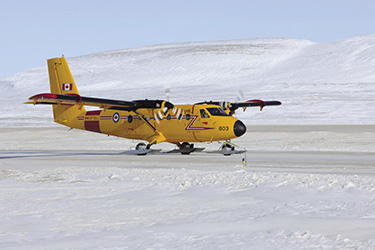
Credit: DND photo CX2013-A002-08 by Corporal Pierre Letourneau
A Royal Canadian Air Force CC-138 Twin Otter aircraft takes off from the Resolute Bay airport during Operation Nunalivut, 10 April 2013
The OAG’s Spring 2013 audit of search and rescue correctly focused upon readiness, human resources, materiel resources, information management and technology, prevention activities and governance. It also offered up some useful findings and recommendations. That said, the omission of provincial and municipal, and RCMP, search and rescue activities—although not surprising, given the focus on “federal support to marine and air” SAR activities and the potential for jurisdictional challenges over audits related to provincial and municipal SAR activities—was unfortunate, given the resulting inability to offer thoughtful analysis of the burgeoning and increasingly contentious issues associated with ground SAR (or incidents on ice where the distinction between land and marine SAR is blurred). On air and marine SAR, additional references to the roles of the volunteer sector, the private sector (which, does, after all, maintain the Cormorant fleet and would be affected by changes in the readiness posture) and secondary and tertiary military SAR assets, would have helped to produce a more holistic analysis. Some observers also would have welcomed a report with additional ‘bite,’ and point to the report’s comparatively mild critiques of the Cormorant, Griffon, Hercules and Buffalo. The report, for example, only flags sensor and data management deficiencies in the case of the Hercules, when in fact, all four types suffer, to varying degrees, from such weaknesses.
The governance component of the OAG’s report, although well-written, also has drawn attention for its comparatively modest length (the report devotes more space to prevention activities and emergency beacons than governance, even though one could argue that deficiencies in governance have for decades been at the root of Canada’s search and rescue problems) and for its comparatively mild recommendation on governance. Did DND’s unveiling of a new National Defence/Canadian Armed Forces and Fisheries and Oceans/Coast Guard Search and Rescue Operational Governance Committee (about which little is known publicly) to enhance coordination on aeronautical and maritime SAR—and the pledge that “National Defence/Canadian [Armed] Forces, with the support of relevant federal departments, will assess the SAR governance structure at the federal level to determine whether it is optimally designed to effectively execute the SAR mandate across departments and to ensure appropriate coordination with federal-provincial and other responders”—subtly fuel a belief in the OAG that improvements in SAR governance were proceeding apace, and thus less in need of a strong jolt from the report? Also intriguing is the degree to which the governance component critiqued the tiny National Search and Rescue Secretariat. Those criticisms are technically correct, but it would have been helpful to fully acknowledge that the NSS has consistently lacked the structure, authority and resources to fulfill its stated mandate.
DND’s in-report responses to the OAG’s recommendations consistently expressed agreement—given the evidence and recommendations there was little else that DND could do—but the expertly-crafted responses left abundant quantities of ‘wiggle room,’ and tended, with some exceptions, to be short on potentially troublesome specifics. Then defence-minister Peter MacKay made some useful points in his announcements of 2 May 2013 and subsequently, but his six-point improvement package tended to be seen as a rather thin gruel. A Toronto Star editorial, for example, argued that the minister had only “danced around the edges of the [SAR] problem.” Certainly the quadrennial review, arguably the flagship of the package, would have been a more useful exercise had the timeline for consultation, research and writing not been so breathtakingly compressed. The then-minister also found himself taken to task, by a number of observers, for his perceived attempt to ‘pass the buck’ to other government departments for the seemingly unending delays in the fixed-wing search and rescue aircraft project.
Where does this leave us? The OAG’s report offered some useful findings and recommendations which, if followed up in a thorough and prompt manner, should materially improve the state of search and rescue in Canada. That said, the range of issues and challenges explored by the OAG—be they related to readiness, human resources, materiel resources, information management and technology, prevention activities or governance—is enormous and clearly cannot be resolved overnight. The new fixed-wing search and rescue aircraft, for example, now appears to be progressing, but no one should breathe easier on this file until operational aircraft start surfacing at squadron level. Similarly, in a heavily stovepiped and bureaucratized environment with an expanding array of stakeholders, governance alone continues to present profound challenges. Although DND promised action on the governance front, one cannot help but wonder if a Cabinet-directed review, a comprehensive and thoroughly holistic review, of the national search and rescue system—a latter-day version of the Cross Report of 1982—might still represent the best way forward.
Martin Shadwick teaches Canadian defence policy at York University. He is a former editor of Canadian Defence Quarterly, and the resident Defence Commentator for the Canadian Military Journal.
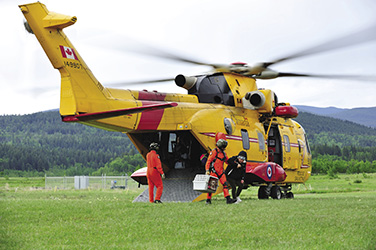
Credit: DND photo IS2013-3025-03
Cormorant helicopter unloading human (and canine) passengers



